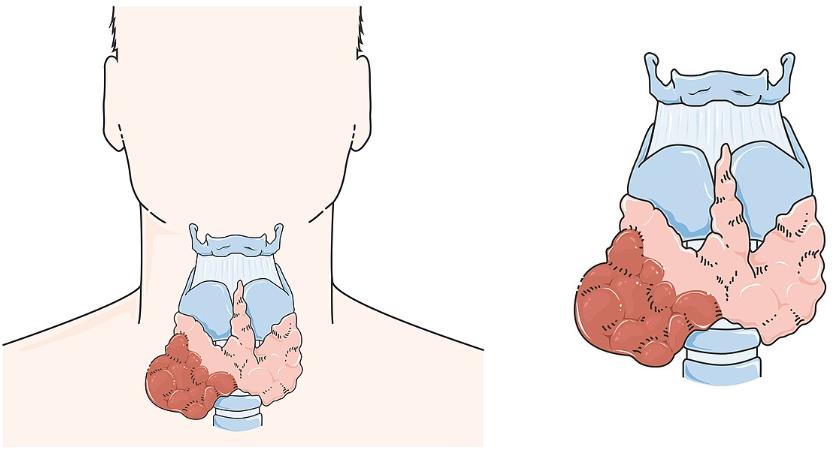With accumulated experience in the antibody development field, Creative Biolabs now offers high-quality in vitro diagnostic (IVD) antibody development services targeting a wide range of diagnostic biomarkers of cancer diseases. Here, we focus on thyroid cancer.
Composed of two lobes connected by an isthmus, the thyroid gland is an endocrine gland in the neck. It is located at the front of the neck. The main function of thyroid gland is to secrete thyroid hormones, which primarily influence the metabolic mechanism and protein synthesis. Thyroid cancer is cancer that develops from the tissues of the thyroid gland. It is a disease that involves the abnormality of cell growth. Potentially, they have the ability to spread to other parts of the body. Symptoms can include swelling or a lump in the neck. Tumors may originate from and spread into the thyroid and this case is not classified as thyroid cancer.
 Fig.1 Images of thyroid cancer.1
Fig.1 Images of thyroid cancer.1
Risk Factors
Radiation exposure (at a young age) is a proven risk factor for thyroid cancer. The risk depends predominantly on the number of radiation people are given. Generally, the risk increases with larger doses and with younger age. Another risk factor for thyroid cancer is genetics. Several types of thyroid cancer are linked to the mutations. Moreover, these mutations could pass on to next generation.
Type
There are mainly four types of thyroid cancer which are papillary thyroid cancer, follicular thyroid cancer, medullary thyroid cancer, and anaplastic thyroid cancer. Diagnosis is often based on ultrasound and fine needle aspiration.
- Papillary Thyroid Cancer
Papillary thyroid cancer is the most common type of thyroid cancer, representing 75% to 85% of all thyroid cancer cases. Women in the 20-55-year age group are more likely to catch thyroid cancer than men. Papillary thyroid cancer is the predominant cancer type in children suffering from thyroid cancer and the patients with thyroid cancer who have undergone previous radiation to the head and neck. Although it can metastasize, it is often well-differentiated, slow-growing, and localized.
- Follicular Thyroid Cancer
Follicular thyroid cancer, also called follicular thyroid carcinoma, is a major type of thyroid cancer, accounting for 15% of thyroid cancer cases. Women over 50 years of age are more likely to catch follicular thyroid cancer. Thyroglobulin, a glycoprotein predominantly produced by the follicular cells of the thyroid, accounts for approximately 50% of all the proteins of the thyroid gland. It can be used as a tumor marker for well-differentiated follicular thyroid cancer.
- Medullary Thyroid Cancer
Originating from the parafollicular cells, medullary thyroid cancer (MTC) is another type of thyroid cancer. It is the third most common of all thyroid cancers, accounting for approximately 3% of all thyroid cancer cases. Approximately 25% of medullary thyroid cancer is caused by a mutation in the RET proto-oncogene. This form is classified as familial MTC. It is called sporadic MTC when it occurs all by itself. When it co-exists with tumors of the parathyroid gland and medullary component of the adrenal glands, it is called multiple endocrine neoplasia type 2 (MEN2).
- Anaplastic Thyroid Cancer
Anaplastic thyroid cancer (ATC) is one of the most aggressive forms of cancer which has a very poor prognosis due to its aggressive behavior and resistance to cancer treatments. Although it is very rare, representing only 2% of all clinically recognized thyroid cancers, the survival of the patients is less than 1 year. Currently, multimodality treatment, such as surgery, radiation, chemotherapy, and targeted therapy, is regarded the best strategy for improving outcome in patients with ATC.
Diagnosis
Thyroid nodules refer to the growth of cells or a lump in the thyroid gland, which is located in the anterior neck region. They are very common in the general population, and a great majority of them are benign. The initial workup for any newly discovered thyroid nodule should include the detection of a serum thyroid-stimulating hormone (TSH) level. The TSH is released from the anterior pituitary and signals the thyroid gland to ensure its function. When thyroid hormone levels are low, the TSH rises responsively and vice versa; thus, measuring a TSH level reveals the differentiation between functional and nonfunctional nodules.
Creative Biolabs has been an incontestable global leader in the development of high-quality antibodies for research, diagnostic, and therapeutic applications. Supported by our powerful IVD platform, we are fully equipped to offer a full range of IVD antibody and immunoassay development services. Please feel free to contact us for more details.
Our services target the following biomarkers for thyroid cancer diagnosis:
Reference
- From Wikimedia: By Laboratoires Servier, CC BY-SA 3.0, without modification, https://commons.wikimedia.org/wiki/File:Thyroid_cancer_--_Smart-Servier.jpg.
For Research Use Only.

